
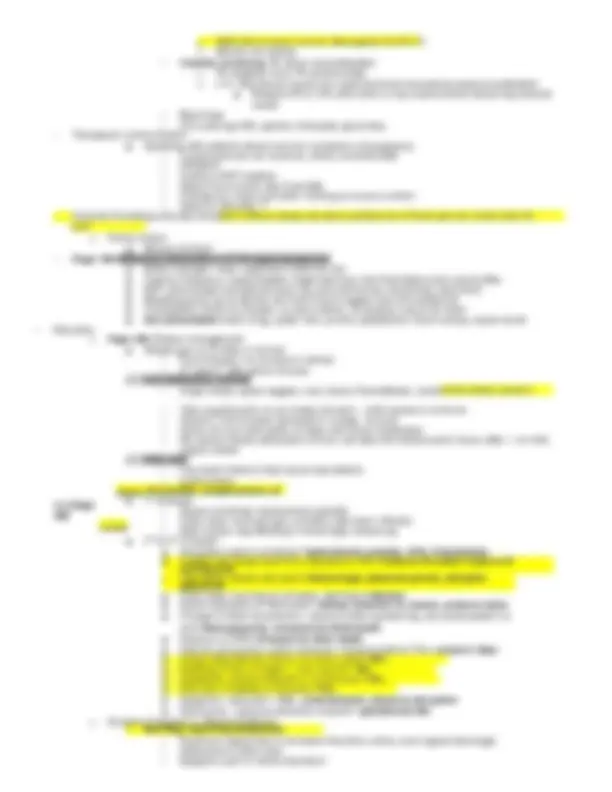

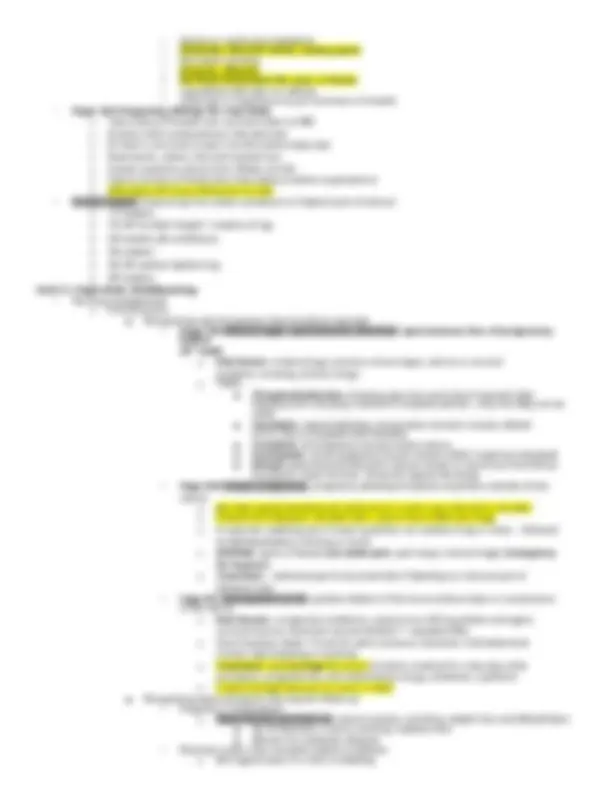

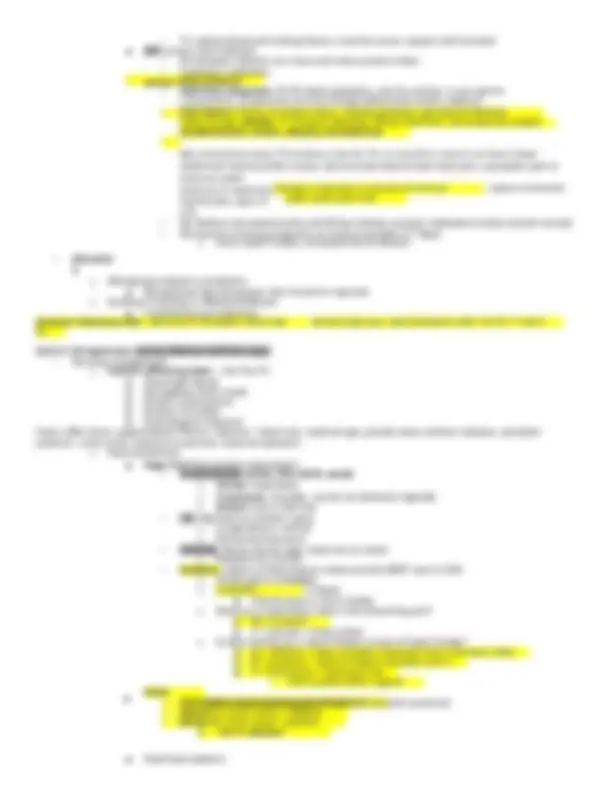




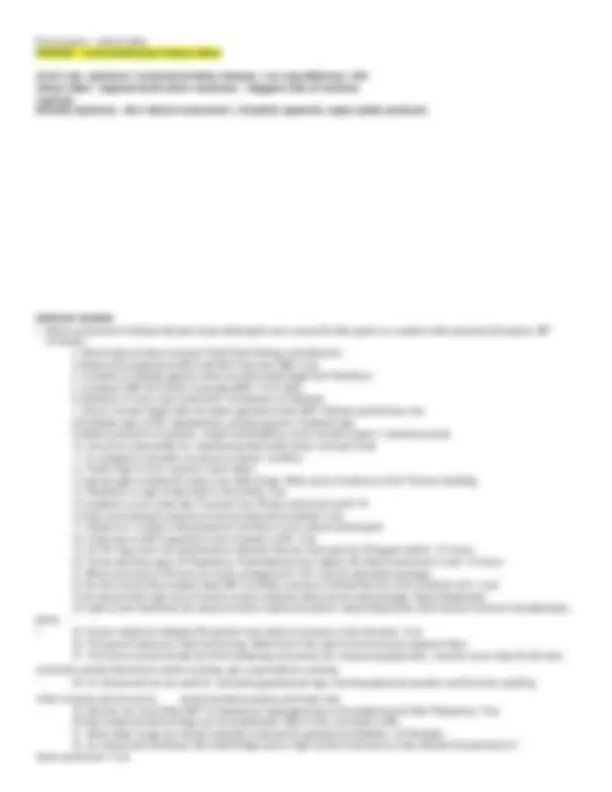



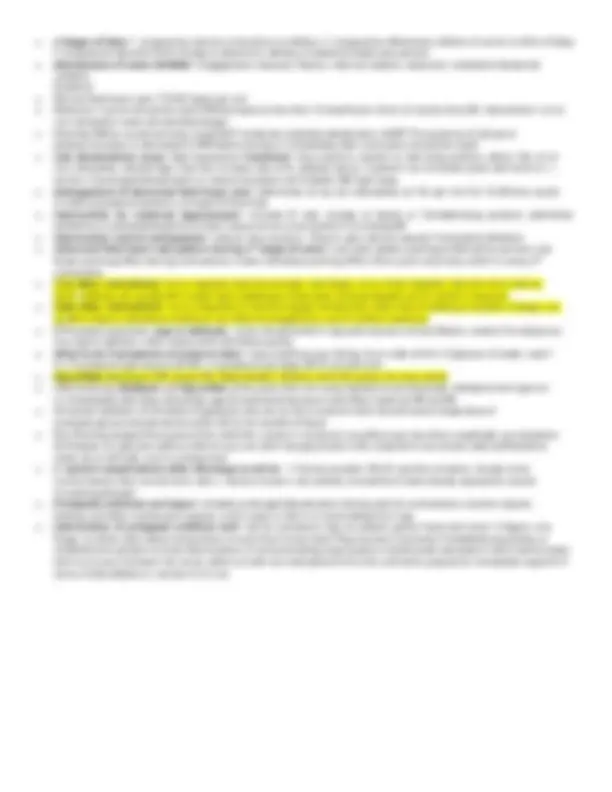


Study with the several resources on Docsity

Earn points by helping other students or get them with a premium plan


Prepare for your exams
Study with the several resources on Docsity

Earn points to download
Earn points by helping other students or get them with a premium plan
Community
Ask the community for help and clear up your study doubts
Discover the best universities in your country according to Docsity users
Free resources
Download our free guides on studying techniques, anxiety management strategies, and thesis advice from Docsity tutors
Childbearing Exam #1 well detailed updated version comprehensive
Typology: Study notes
1 / 22

This page cannot be seen from the preview
Don't miss anything!















Hegar’s
sign
Nursing Management
o Page 178 Signs/symptoms related to pregnancy
▪ Categorizing signs/symptoms of pregnancy
signs of pregnancy, COULD be caused by something other than pregnancy,
o Breast changes, amenorrhea, nausea and vomiting, urinary frequency,
fatigue, quickening
o Positive pregnancy
test,
(false), (cervical softening),
Chadwick’s sign (increased cervical vascularization), (softening of lower
uterine segment), enlarging uterus, ballottement (pushing of the uterus – do you
feel a fetus move and come back?)
kicking
▪ What is considered normal or expected?
o Breasts: increase in size, fullness, heaviness, tingling, darkening of the areola, lactation
can occur as early as 18 weeks
o GI: delayed GI motility, constipation, heartburn, nausea and vomiting,
hemorrhoids, increased vascularity of gums, increased saliva
o GU: increased urination; NORMAL
o Cardio: pulse increase, increased blood volume, increased cardiac output
o Respiratory: increased O2 consumption, nasal and sinus congestion,
increased vascularity
o Musculoskeletal: center of gravity shifts, unsteady gait
o Sensory: sciatica, restless legs, muscle cramps, syncope, tension headache
o Integumentary: melasma mask (hyperpigmentation), striae gravidarum (stretch
marks), vascular malformation (spider veins)
o HR: slight increase
o BP: should not change dramatically from baseline
o RR: SOB is common, difficulty breathing is NOT
o O2: remains stable
o Temp: can slightly increase
▫ Page 187 Calculating GTPAL
▪ REMEMBER! With multiples, they count as one pregnancy!
▫ Page 178 Calculating Naegele’s Rule/EDD (expected date of delivery) – two ways to calculate
▪ First day of last menstrual period
months OR
▫ Analyzing labs
preterm
Braxton
Hicks
▪ T: term
▪ A: abortion
▪ L: living
Goodell’s
sign
Add 7 days – 3 months + one
year
gravida
▪ Blood work
▪ Live vaccines are contraindicated (page 193)
o No booster while pregnant, can offer postpartum
o Toxoplasma- Don’t not clean cat litter, eat raw meat or touch dirt
- Titer
s o Rubella/Varicella: provides passive
immunity
▫ Page 183 Preparing siblings for new baby
o Take child on Prenatal visit. Let them listen to FHR
o Involve child in preparations; help decorate
o If child in crib move to bed 2 months before baby due
o Read books, videos, dvd and hospital tour
o Answer questions about birth. Babies are like
o Take to homes of friends who have babies (realistic expectations)
o With baby doll show sibling how to hold
o Priority actions
▪ Recognizing signs/symptoms that should be reported
before
th
week
o Risk factors : maternal age, previous miscarriages, uterine or cervical
problems, smoking, alcohol, drugs
o TYPES:
▪ Threatened abortion : showing signs but cervix hasn’t opened, light
bleeding and cramping- treatment complete bedrest ..only one baby can be
safed
▪ Inevitable : vaginal bleeding, strong lower stomach cramps, dilated
cervix, fetus is expelled with bleeding
▪ Complete : all pregnancy tissues leaves uterus
▪ Incomplete : some pregnancy tissue remains (D&C might be indicated)
▪ Missed : placental and embryonic tissues remain in uterus but the embryo
has died or never formed – brownish vaginal discharge
uterus
o s/s : light vaginal bleeding with abdominal or pelvic pain referred to shoulder
o if blood from fallopian: shoulder pain, urge to have a BM; pink tinge
o if ruptured: stabbing pain in lower quadrant, can radiate to leg or chest, – followed
by lightheadedness, fainting or shock
o GOPHER - gush of blood; one sided pain , pain stops, hemorrhage, Emergency
for Rupture
o Treatment – methotrexate if only stretched; if bleeding sur remove part of
fallopian tube
of the uterus
o Risk factors : congenital conditions, exposure to DES (synthetic estrogen),
cervical trauma, excessive cervical dilation = repeated D&C
o Starts between weeks 14 and 20: pelvic pressure, backache, mild abdominal
cramps, light bleeding or spotting
o Treatment - abd Cerclage (tie cervix) tocolytics, bedrest for a few days after
procedure, progesterone, anti inflammatory drugs, antibiotics, hydration
o I need Cerclage because my cervix is weak
▪ Recognizing signs/symptoms that require follow-up
o Hyperemesis gravidarum : severe nausea, vomiting, weight loss and dehydration
▪ Tx : IV hydration, control vomiting, stabilize mom
▪ Monitor for metabolic alkalosis
o NO vaginal exam if a mom is bleeding
o Stabilize mom first! ABCs
o Now, is baby still alive?
o Medication management for high-risk conditions
▪ Page 280
after 20 weeks> seizure related
older than 40yo, pre-existing medical or genetic conditions
leaking, reduced organ perfusion, can affect liver and brain function
o Page 282 HELLP syndrome : lab diagnosis for a variant of preeclampsia that
involves hepatic dysfunction – starts because of hypertension
▪ H : hemolysis : breakdown of RBCs
▪ EL : elevated liver enzymes – AST, LST, LFTs
▪ LP: low platelets (normal 400,00-150,000)
▪ Increased risk for: pulmonary edema, renal failure, liver hemorrhage or
failure, DIC, placental abruption, acute respiratory distress syndrome,
sepsis, stroke,
fetal and maternal death
headache,
blurred vision, photophobia, epigastric pain, intrauterine growth restriction of
fetus
extremities or face), deep tendon reflexes = hyperreflexia, clonus = jerky spasms,
rhythmic and involuntary (over 3 )
Severe preeclampsia: BP126/110 prevent seizures, control blood pressure
o Assess respirations, level of consciousness, intake/output
o Pregnancy-safe medications : methyldopa or hydralazine
o
▪ Keep calcium gluconate
bedside
▪ Monitor Mg levels
(can also stop them)
▪ Page 289 Eclampsia : onset of seizure activity or coma in a woman with preeclampsia and no
prior history
▪ Page 242 Diabetes: can be pregestational or gestationa l (management is pretty much the
same)
hyper/hypoglycemia, increased risk for postpartum hemorrhage, sudden or unexplained
stillborn,
congenital malformations
o 1
st
trimester: reduced
o Birth: decrease
o Breastfeeding: decrease
o Negative = less than 130- 140
o Positive = more than 140 (requires further testing)
o Recognizing signs/symptoms
low lying placenta classified by where egg implants and how
much of the cervix is covered (total, partial, marginal)
o placenta covers some or all of the cervix
o Dx – with/ ultrasound
▪ usually occurs towards ends of 2
nd
trimester or later
o Tx : bed rest, monitoring, possible C-section depending on degree of cervical coverage
uterine lining
▪ If patient has protein in urine and High BP; nurse should give Magnesium
Sulfate
tendon
reflexes
initially
Magnesium sulfate : manage and prevent
seizures
Preeclampsia: hypertension AND
proteinuria
▪ Placenta
abnormalities
o 2
nd
trimester: starts to
increase
o 3
rd
trimester: may increase to 2-4x more than
“normal”
o NO VAG EXAMS (if
bleeding) o S/S can cause painless, bright red , severe vaginal bleeding, fundal height
greater
than gestational age, non-tender
uterus
o MEDICAL EMERGENCY : C-section is necessary
o causes/risk factors : hypertension, abdominal trauma, cigarette smoking, alcohol
or cocaine use, blood clotting disorders, diabetes, previous history
▪ DIC (disseminated intravascular coagulation): “excessive clotting and bleeding at the same time”
into bloodstream
pain,amopnitic
fluid port wine
color
o s/s : abdominal pain , vaginal bleeding, rigid-board like abdomen/fundus,
uterine contractions, port wine-stained amniotic fluid, dark red vag bleeding,
sudden
o Powers (changing of
▪ Primary powers
o I f not ready not dialted completely mom change positions
▪ Secondary powers
▪ External powers
ripen cervix)
o Positioning
▪ Encourage mom to find whatever position is the most comfortable for her
▪ Frequent changes in position: relieve fatigue, increase comfort and improve circulation
o Recognizing signs/symptoms
▪ Labor: process of moving fetus, placenta, and membranes out of uterus through the birth canal
o Lightening : fetus drops into pelvis
o Bloody show/mucus plug: pink or blood-streaked mucus
▪ Page 327 Stages of labor
o True contractions and cervical changes
1. Early phase: up to 5cm of dilation
▪ Usually the slower phase, may go quicker after 1
st
pregnancy
2. Active phase: 6-10 cm
Transitional phase = 8+ cm
o Epidural
▪ Offer between 4cm - 7cm
▪ Can give up to 7cm (then it cannot be given)
to push properly)
hypotension, heparin within 12hrs, blood disorder, infection at site,
allergy to anesthesia, refusal, some cardiac conditions
o Time for delivery!
o Push with contractions; rest when contraction over
o Latent = passive movement
o Active = actively pushing
o You MUST assess placenta
▪ All of it HAS to come out (bleeding, infection)
▪ Placenta accreda: placenta is implanted too deeply into uterus
o Immediate recovery
o Usually 2 hours – monitor bleeding and any abnormalities
o Page 328 7 cardinal movements of the mechanism of labor
brought closer to fetal chest
realigns with baby’s back and shoulders
▪ Analyzing contraction characteristics
beginning of the next)
relax Questioning orders based on client condition
o Page 396 Priority
▪ Actions based on fetal heart patterns
o Absent = not good sign
o Minimal = 5-10bpm difference
▪ Can occur if baby is asleep or if narcotics have been administered
o Moderate = 10-25bpm difference
▪ Normal
o Marked = over 25bpm difference
▪ Generally indicates distress
o Knowing if teaching is effective/non-effective
▪ Recognizing labor stages/phases
▪ Relieving labor discomforts
▪ Page 414 Preterm labor- birth that occurs between 20- 36w6 days
periodontal disease, stress
abd pressure. Constant low back pain, mild abd , no diarrhea, reg contractions no pain,
ruptured membranes.
▪ Page 425 Chorioamnionitis : bacterial infection of amniotic cavity
▪ Page 426 Dystocia : dysfunctional labor = long, difficult or abnormal labor
position during birth and labor, psychological response of mom
abnormalities, malpresentation or position of fetus, uterine overstimulation
▪ Page 428 Precipitous labor : labor less than 3 hours
▪ Labor induction : most HCPs will induce at 41 weeks
mom; probable issues with baby risk for spontaneous abortion are spontaneous membranes EARLIEST TEST TO
chromosomal
abnormalities
o Fetal lung maturity ( surfactant)med to help antenatal betamethasone ( steroid)
Diabetes mellitis – pregestational Screen 24-28weeks screen glucose test 3 hours
pregnant
nd
trimester insulin needs are higher then in 1
st
trimester
weekly appts
of 8-10 normal)
edema; headache, reduced placental perfusion ; increased clonus; Magnesium sulfate calcium gluconate
sustainable PG or missed abortion
Antenatal glucocorticoids, Tocolytics
Red dark, Excruciation
Finger sticks, First trimester Hypoglycemia-congenital birth defects; Later onset ( gestational diabetes (24-28 week),
Eating control diet/ exercise
baseline; mom changed oistions
th
degree worst degree;
preferences, ASIAN cultural
o Risk factors – race, prior, age, dm, htn, bleeding,
o Prevention- place on high risk; incopentence cervix (cevage), extra prenatal visit,
o Intervention-
o Fetal fibronectin- swab at 22-34 if postive = complication, cervial length
o Cervical shortening - effacement
o Know sign effacement 80% cervix dialter 2xm or greter
Chorioamniotis – tachycarfdia, feverm uterus tender, foul order of amniotic fluid 0 infection of amniotic cavity , prolong
deceleratins
Baby doesing past 42 weeks= POST TERM= maconsomia ( big baby) , complications dysfuntional labor , injury bleeding,
infection ( placenta gives out
Ingdice labor or c section ( aging placenta ,
Dystocia- dysfunctional laor – inffective contractions ( too weak , too strong powers) passage, passenger,
Gyencoid most favoorabile shape of pelvis ( round)
LOA most favorable psotion of baby
Cephalopelvic disportion = big head baby
Hypertonic – 6-10 in 10 mins= give tocolytics
Hyptonic uterine contractions = pitocin
Precipituos labor – labor less than 3 hours w/o augementaion= risk factor trauma coacaine, htn, uterues tacystole
Bishop score 5 or less nt candiate/ cervid is assessed postiom, constitancy, dialte , effacement,
Induce mom – placenta previa- contraindicated
Bleeding induction is contracincated
Hypoglycemia 39.Maternal death is NOT a direct risk following an amniocentesis- True
40.Which exam looks like Rh+ antibodies in maternal blood= Coombs test
Yellow Alert boxes from book
o BP measured on same arm each visit always while sitting; if elevated let rest and retake (page 188)
o Exercise for PG = exercise every day for 30mins; like swimming, cycling, stretching; avoid activities that require holding
breath and Valsalva maneuver; should be able to converse while exercise; in air conditioning (NO hot tub, saunas); After 4
th
month of PG no exercises on back; rest 10 mins after exercising; drink water while exercise; drink 2-3 8oz of water after; (page
o Stop exercising and call MD if : SOB, dizziness, headache, numbness, tingling, chest pain, reg painful contractions,
decrease fetal activity, vaginal bleeding, dyspnea before exertion, muscle weakness affecting balance, calf pain or swelling
o Family members who will come in close contact with infant less than 12months are up to date with single of Tdap at
least 2 weeks before contact (page 193)
o Airplane Travel when PG = safe if no medical/ obstetric complications; airlines allow travel up 36 weeks; during flight
wear seatbelt; To minimize lower edema, or thrombosis wear support stocking, avoid restrictive clothing, move legs
periodically, ambulate occasionally, stay hydrated
o Sexuality in PG = libido lower in 1
st
trimester, increase in 2
nd
; alternative behaviors, alternate positions; Abstain from
missionary if cramping or bleeding; Avoid intercourse of hx of premature dilation cervix ask Dr; partner should not blow air
into V can cause air embolus (page 197)
o Signs of Potential complications : in 1
st
trimester = severe vomiting; chills, fever; burning urination; diarrhea; abd
cramping, vag bleeding.(miscarriage, ectopic pg) In 2
nd
rd
Trimester = persistent severe vomiting, Sudden discharge
fluid before 37 weeks (PPROM); Vag bleed w abd pain (miscarriage , placenta previa, abrutptio); chills, fever, burning
urination, diarrhea (infection); severe back/ flank pain; change in fetal movements;, absence of fetal movements after
quickening (fetal jeopardy/ intrauterine fetal death) , absence of fetal HR; uterine contractions , pelvic pressure, cramping
before 37 weeks; visual disturbance) swelling of face, fingers, sacrum area; muscular irritability/ seizures; epigastric/ abd
pain; glycosuria, positive glucose tolerance test (gestational diabetes (page 200)
o High mercury harm fetal development (nervous system) Avoid eating shark, swordfish, king mackerel, tilefish; check
local advisories about fish caught if not available only eat 6oz or less and no other fish during that week. Eat 12oz of fish
per week (shrimp, salmon, pollock, catfish, canned light tuna (limit albacore or white tuna) (page 213)
o Calcium Sources ( NON milk )- sardines, salmon, beans, baked beans molasses, tofu, collard, turnip, kale, cornbread,
muffins, French toast, waffles, figs, orange juice, pesto sauce, cheese sauce (page 215)
o Iron supplement teaching = Vit c helps w/ absorption, take on empty stomach, decrease iron absorption- bran, tea,
cofee, milk, egg yolk; don’t double dose if missed dose take within 13 hrs of scheduled dose, (page 316)
o Avoid Bone meal many times has lead; ask MD for a different source of Calcium
o PG women who contract listeriosis from Listeria are at increased risk of miscarriage premature birth, still birth; Do not
consume unpasteurized milk (avoid brie, camembert, queso blanco, panela, asadero cheese. Only consume luncheon
meats hotdog, bologna if reheated or steaming hot; Do NOT consume store bought salads such as egg, chicken, ham
seafood (page 221)
o Managing N/V during PG = eat starchy food, toasts, crackers; avoid excessive fluids early in day or when nauseated; eat
small frequent meals every 2-3 hrs, avoid large meals, avoid skipping meals, no sudden movements; decreased intake of
fried fatty food; inhale fresh air or good ventilation; try salty/ tart food when nauseated; try herbal tea w/ Rasbery leaf &
peppermint; try ginger; wear motion sickness wristband, Vitamin b6 (page 222)
o In assessing fetal movement remember usually not present during sleep cycle or depressed with CNS depreesant meds,
alcohol, smoking
o After amniocentesis administer Rh0D to women is Rh negative Is standard
o Iron deficiency falsely increased A1C (page 247)
o Complication of undiagnosed/ partially treated hyperthyroidism is thyroid storm occurring from stress from labor,
birth, infection, preeclampsia, surgery. Women with thyroid storm give o2 , IV fluid and high dose of PTU. After give
iodine
o Women w/ sickle cell anemia are not iron deficient (avoid prenetal vitamins with iron can cause iron overload (pg 267)
o Meds to avoid when PG due to tetrogenic effects- Accutane ( isotretinoin), valproic acid,
o Assessing Deep Tendon reflexes= No response 0 - 4+ Hyperactive response ; 2 is normal expected response
o Assessing clinical signs of Preeclampsia - Take BP meds; sit take BP, use right arm, report increase of BP, report
decrease in urine output, assess fetal movements daily( 4 or fewer movements per hour may indicate fetal
compromise); Keep daily log or diary of assessments; report headache, dizzy, blurred vision, seeing spots to MD
immediately (pg 285)
o Hospital Measures Women w/ Preeclampsia = environment (quiet, non-stimulating, light subdued); Seizure
precautions (suction, oxygen, call button); Emergency meds available (Hydralazine, Labetalol, Nifedipine, Magnesium
Sulfate, Calcium Gluconate); emergency birth pack (pg 287)
o High serum levels of MG cause smooth muscle relaxation (uterus) policy admin 4-6gram loading dose
followed by 1-2g Maintenace dose
o If Mg sulfate toxicity is suspected to prevent respiratory and cardiac arrest. Discontinue Mg and give antidote;
Calcium Gluconate
o Mg sulfate = high alert drug. NEVER ABBREVIATE magnesium Sulfate as MgSO4 anywhere in medical record (page 289)
o Eclampsia Emergency treatment : stage invasion (eyes fixed, twitching of face muscles; stage of contraction 15-
(eyes protrude , blood shot, body muscles tonic ; stage convulsion- muscle relax and contract clonic respiration halted and
begins with long deep stertorous inhalation, coma ensue INVETRERVENTION : keep airway, head to the side, place pillow
under 1 shoulder; call for assistance don’t leave bedside; raise side rails pad with folded blanket; observe and record seizure